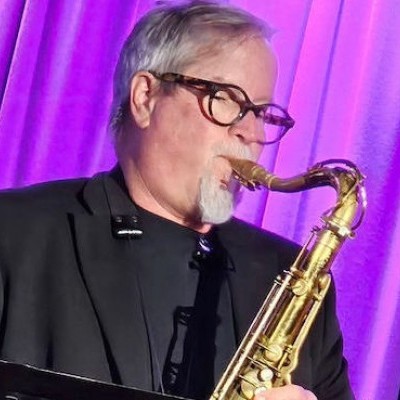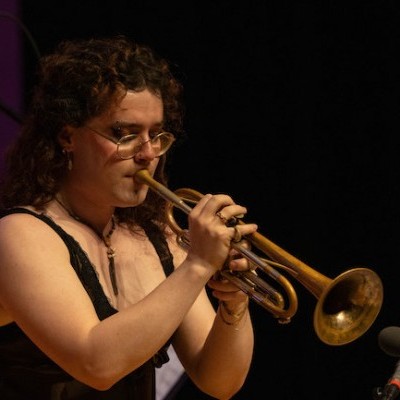Oct 28, 2025 10:47 AM
In Memoriam: Jack DeJohnette, 1942–2025
Jack DeJohnette, a bold and resourceful drummer and NEA Jazz Master who forged a unique vocabulary on the kit over his…

“There’s a lot of untapped potential in that classic big band literature,” Argue says, noting that it serves as inspiration.
(Photo: Lindsay Beyerstein)In 2010, when Darcy James Argue wrote “Dymaxion,” a masterstroke for large ensemble, he knew it was the beginning of something bigger — a series of musical portraits, each celebrating a forward-looking 20th-century thinker. This September, the Vancouver-born composer realized this vision with the release of Dynamic Maximum Tension (Nonesuch), a two-disc recording of 11 compositions constellated around these largely underappreciated historical figures.
“‘Dymaxion’ was really the beginning of the concept for this album, of my looking to figures from the past who represented something exciting and optimistic in their day, for inspiration in the present day,” Argue said in an interview from Brooklyn, where he now lives.
These compositions are more than paeans to yesterday’s thought leaders, however. In crafting the works, Argue conscientiously studied each figure and fashioned the music to reflect the ethos of their lived experience.
For instance, architect and inventor R. Buckminster Fuller (1895–1983) served as the catalyst for “Dymaxion” — and hence the entire album — with his futuristic designs and humanitarian aims; Argue borrows the track’s title from Fuller’s own shorthand for “dynamic, maximum, tension,” his concept of maximum advantage through minimal expenditure of energy. Like Fuller’s geometric images, Argue’s streamlined use of space and motion (spinning horns, percussive thrust) incites the imagination.
This composition has held a regular spot in the live performances of Secret Society, Argue’s superb 18-seat big band, since its inception, though it would be more than a decade before Argue released a studio version of the track. During these years, his career was advancing rapidly: three highly lauded albums for indie label New Amsterdam Records; multiple nominations for Grammy and JUNO Awards; legions of commissions and grants, including a Doris Duke Performing Artist Award and a Guggenheim Fellowship; and teaching posts at prestigious institutions like Manhattan School of Music, Princeton University and The New School.
The latest record adds two milestones to this list of accomplishments. Not only is Argue making his label debut on Nonesuch, an imprint whose curatorial vision he has long admired, but he’s adjusting his artistic trajectory.
“This double album, on such a major label for the first time, is an opportunity for me to reintroduce the public to my work,” he said. “It’s really the first album of material not related to multimedia since my debut, Infernal Machines [2009]. The two albums that follow that up, Brooklyn Babylon [2013] and Real Enemies [2016], were both documentations of the music for productions at the BAM Next Wave festival. That’s music that I’m extremely proud of, of course, but this album is a great opportunity to give everybody a peek at all of the other music that I’ve been working on for the past 10-plus years.”
Importantly, it’s through Argue’s “other music” that one can track his ever-deeper immersion into big band as an art form. These days, he asserts, big band composers might avoid certain stylistic conventions in a bid for innovation. For his part, however, compositional innovation derives from an evolving fluency in that traditional big band language.
“There’s a lot of untapped potential in that classic big band literature,” Argue pointed out. “And as I have grown more experienced as a composer, I’m getting more comfortable in finding ways to reach further back and draw on that history.”
A prime example from the album is “Codebreaker,” a commission for The Jazz Knights, an elite big band ensemble with the U.S. Military Academy. In writing this piece, Argue said, he wanted to capture the intensity of a 1940s swing band without replicating its expected harmonic constructs and rhythmic templates.
“I tried to build something that had the feeling of a classic band flag-waver but with a contemporary sensibility, using an almost algorithmic mathematical process that, hopefully, feels organic to the listener,” he said.
These compositional twists speak to the life and work of Alan Turing (1912–’54), the British scientist who broke the purportedly indecipherable Nazi war codes and, by so doing, hastened the end of World War II. Later, he was prosecuted for his sexual orientation, underwent state-imposed chemical castration and died by what British authorities deemed a suicide. Argue took exception to the cruel mistreatment of the brilliant mathematician.
“Turing is the father of modern computing and also the philosophical father of artificial intelligence,” Argue said. “It’s interesting that his story is taking on more and more salience as we move further and further into the future.”
One might make a similar observation of the stage and screen dramatist Mae West (1893–1980), another of Argue’s subjects. He became interested in her story after reading the sonnet “Mae West’s Advice,” by poet Paisley Rekdal. He based his composition by that name, with its neo-standard feel, on these 14 lines.
“As I learned more about Mae West, it was clear that she was someone who belonged in the category of inspiring mid-20th century pioneers who are reflected in this album,” Argue said, citing the star’s doggedness in challenging social hypocrisy, her keen business sense and her tremendous power in Hollywood as aspects of her persona that often go unremarked.
Significantly, too, Argue discovered that West was one of the first mainstream stars to film with Duke Ellington (1899–1974) and his Orchestra. In her Belle of the Nineties, a Western from 1934, she fronts the Ellington band on “My Old Flame,” the tune that provided the stylistic touchstone for Argue’s lone vocal composition on the release (with guest singer Cécile McLorin Salvant).
Argue’s fascination with Ellington’s work receives more direct expression on “Tensile Curves,” a 35-minute opus that rejoins Ellington’s 1937 “Diminuendo And Crescendo In Blue.” Commissioned by the Hard Rubber Orchestra and the Newport Jazz Festival in 2014, “Tensile Curves” arose out of Argue’s systematic deep-dive into Ellington’s oeuvre and his growing enthrallment with the intricacies of the tune that so galvanized the 1956 Newport Jazz Festival.
With this track Argue also wants to set the record straight about that tune’s formal structure — which, he contends, has been wrongly analyzed. Part of this correction is his own application of Ellington’s devices in “Tensile Curves,” which migrates through the same five keys, the same harmonic pattern, as the Ellington tour-de-force. Instead of a diminuendo, however, Argue uses a decelerating tempo to generate the requisite excitement. This technique is his own version of what he calls Ellington’s masterful use of “misdirection.”
“The kind of games that Ellington plays with the listener on ‘Diminuendo In Blue’ are unlike anything I’ve ever heard, even in Ellington’s entire catalog,” Argue said. “The way he leads you down one path and then swerves to another — it’s just astounding.”
From among the original big band luminaries like Ellington, Argue was also drawn to Cab Calloway (1907–’94) and his trove of swing-era hits; Argue especially admired the singer/bandleader’s popular dance number “Jitterbug,” by trumpeter Edwin Swayze (1906–’35). Alluding to Calloway’s arrangement of the tune, Argue wrote “Single Cell Jitterbug,” a fresh (albeit noir) understanding of the now-familiar big band tropes that Calloway popularized in the 1930s.
“There are some direct quotes from ‘Jitterbug’ in the piece — some pretty obvious ones,” Argue said. “A lot of that came from listening back to that original Cab Calloway recording and thinking, ‘This feeling is so great and the band’s playing so amazing. What does this mean in 2023? What does it look like to take those elements and find a way to make them make sense in a contemporary context?’”
Not all of the pieces invoke mid-century inventiveness, however. The moody, wailing “All In,” for instance, memorializes trumpeter Laurie Frink (1951–2013), an early member of Secret Society, who passed from cancer a decade ago. An influential instrumentalist and educator, Frink played under several notable big band leaders, among them Gerry Mulligan, Benny Goodman, Bob Mintzer and Maria Schneider.
“Laurie is still very, very deeply missed. It certainly meant a lot to me to pay tribute to someone who gave me and the band a direct connection to the history of this music,” Argue said. “When I was thinking of people who were trailblazers, ahead of their time, Laurie is one of the first people I thought of.”
And “Ebonite,” another Hard Rubber Orchestra commission, acknowledges Argue’s interest in Argentinian culture — specifically, the chacarera style of folk music, from the north of the country, with its engaging metrical ambiguity. He brings this same rhythmic fluidity to this track’s tilting, percussive angles and florid, melodic choruses.
But Argentina sparks Argue’s interest for a second, more personal reason: One of its global industries is the production of ebonite, a type of hard rubber formed through the vulcanization of latex from tropical rubber trees.
“Ebonite is used for many different things, but most important for our purposes are saxophone mouthpieces and hockey pucks,” he said. “So, the title is a bit of a joke on the Argentinian contribution to Canada’s national pastime.”
Argue alludes to another Canadian pastime in “Last Waltz For Levon,” a loping country ballad dedicated to Levon Helm (1940–2012), drummer for the beloved Toronto-based musical group The Band. Helm was its sole American member.
“When Levon passed, I was thinking about his open-eared, musical omnivorousness,” he said. “That was a big part of his drumming, growing up in the deep South, listening to Black radio, incorporating the New Orleans influence into his own style. [He brought] that into this group, one of the most famous Americana groups of all time. Even though they’re mostly Canadian.”
Argue himself left Canada in 2000 to study at the exclusive New England Conservatory of Music under Bob Brookmeyer (1929–2011), the pre-eminent trombonist and composer. As a commission for NEC’s 150th anniversary, Argue wrote “Wingèd Beasts,” a sophisticated contemporary selection that premiered at a 2018 concert honoring Brookmeyer.
“As I was writing the piece, there was an insistent chromatic line that happens throughout,” Argue recalled. “When I tried [the figure] as a bass line, I realized that it was the bass line to Bob’s piece ‘The Nasty Dance.’ I just decided to embrace it. It felt like Bob was looking over my shoulder and [telling me] to use it. So, the middle half of the piece is a heart-on-my-sleeve tribute to Bob in general, and ‘The Nasty Dance’ in particular, which remains one of the greatest pieces of big band music ever written, in my opinion.”
Curiously, both the oldest and the newest compositions on the album flow from Argue’s empathic reaction to modern wars that have stunned the world. The first of these, “Ferromagnetic,” he wrote out of “anger, shock and horror” at the Nisour Square massacre in 2007, during the Iraq War, when Blackwater International military contractors “slaughtered Iraqi civilians with impunity,” he said.
“It’s a piece that is reflective of the darker side of this mid-century optimism that otherwise infuses the album. I felt that there needed to be some recognition of that side of progress,” he said. “The role that that tune plays is [to add] some bracing reality to what is otherwise a very hopeful album.”
Similarly, the recording’s newest composition, “Your Enemies Are Asleep,” gives voice to Argue’s dismay over the Russian invasion of Ukraine that began in 2022. He found inspiration for the 16-bar blues — spare and direct in its sorrow — in the timeless Ukranian folk song “Nich Yaka Misyachna,” often sung as a lullaby.
“I was really taken by this song — it’s one of those old-world melodies that is very haunting,” he said. “I was able to fill in some of the cultural context, about Stalin’s purges of the Ukrainian bandura players in the 1930s, including Vasyl Ovchynnikov, one of the composers of the song [with kobzar Andriy Voloshchenko], who was almost certainly executed by Stalin in one of those purges. That added a whole other layer of meaning to it.”
In Argue’s quest for such “layer(s) of meaning” in others’ lives, he reminds us of the existential anxiety that gripped mid-century society — a disquietude that has yet to abate. Through his music, he offers a response.
“In that society, there was a feeling of tremendous optimism and progress,” he observed. “There was the idea that the future is something that we shape ourselves — it’s not something that happens to us.
“So, really, the unifying idea behind the music on this album is that the future is something that we make.” DB

Jack DeJohnette boasted a musical resume that was as long as it was fearsome.
Oct 28, 2025 10:47 AM
Jack DeJohnette, a bold and resourceful drummer and NEA Jazz Master who forged a unique vocabulary on the kit over his…

“I’ve told students, ‘I don’t mind if you use AI for this or that project,’” says MIT’s Pascal Le Boeuf. “‘But you need to tell me.’”
Sep 18, 2025 11:14 AM
A standard joke when it comes to discussing artificial intelligence, or AI, is that it’s developing so rapidly that…

Chuck Manning Works for NASA … and plays jazz.
Sep 18, 2025 11:23 AM
Congratulations! After years of study, you’ve earned your degree in jazz performance. But let’s face it: Making a…

Always a sharp dresser, Farnsworth wears a pocket square given to him by trumpeter Art Farmer. “You need to look good if you want to hang around me,” Farmer told him.
Sep 23, 2025 11:12 AM
When he was 12 years old, the hard-swinging veteran drummer Joe Farnsworth had a fateful encounter with his idol Max…

“Make time and energy to meet people and make friends,” suggests Millie Ahearn, a student at DePaul University.
Sep 18, 2025 11:32 AM
For many students, the transition into a collegiate jazz program can feel overwhelming — new peers, unfamiliar…